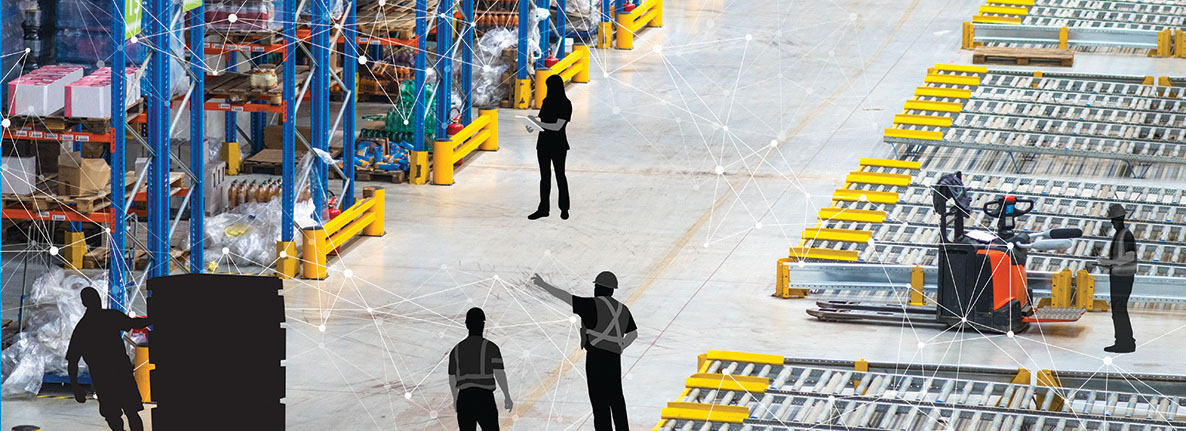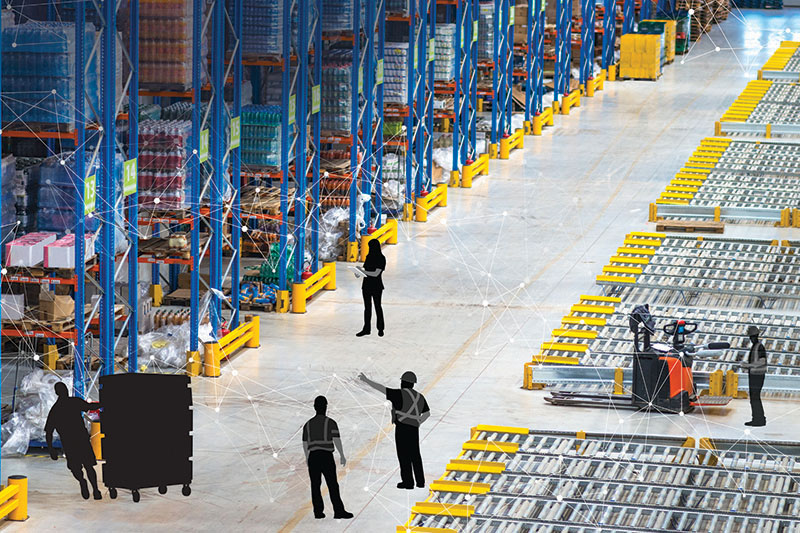Labor Management Systems (LMS):The new age of employee engagement
Here’s how companies are using their labor management systems (LMS) to improve workforce performance, increase logistics resilience, and prepare to engage employees far into the future.

Managing labor has never been an easy task. In the months leading up to the COVID-19 outbreak, U.S. companies were dealing with persistent, historically-low national unemployment rates hanging in the 3.5% range. Warehouses, distribution centers (DCs), and logistics providers were feeling the pinch of the labor shortage as their businesses expanded right along with the economy.
By April, the labor landscape had shifted dramatically, with the national unemployment rate spiking to 14.7%. At least somewhat situational in nature, this increase may not last in the post-COVID-19 world, and shippers will continue their slow progression over to implementing more automated operations supported by advanced technology.
Where artificial intelligence (AI), machine learning (ML) and blockchain may be making the biggest headlines in supply chain management (SCM) technology this year, one SCM workhorse is helping companies improve their labor management approaches right at a time when companies could really use the extra help in this area. Aggregating data and reports on employee productivity—either individually or for groups—labor management systems (LMS) provide visibility into where companies are allocating their labor budgets and help them optimize those human assets.
According to Dwight Klappich, research vice president for Gartner, LMS also helps companies assess and address labor availability issues. In fact, he says this capability has become a selling point for companies that may be on the fence about investing in the software. “In the past, companies used LMS to help identify the bottom 20% of their workforces in terms of productivity,” says Klappich, “and then replacing them with more productive employees.”
Companies still want those performance reports, Klappich adds, but now they’re leaning on LMS to help them make good employee allocation decisions during high and low seasons and across multiple different warehouses. “They want to see labor performance and metrics across facilities and kind of compare and contrast the information (i.e., why this facility is doing better than the next one),” Klappich explains, “whereas in the past each warehouse was usually managed independently.”
Pointing to one large food and beverage company that has over 1,000 warehouses worldwide, most of which are very small operations with two to three employees, Klappich says justifying one LMS for each of those facilities would be impossible. Today, he says a combination of the Cloud plus the efforts of vendors like Easy Metrics, Manhattan, and Blue Yonder have enabled this kind of multifacility data aggregation.
“Software providers are giving logistics managers the ability to say: ‘I’m collecting that at the facility level, but I can actually render that information at a more aggregate level across all locations,’” Klappich explains. “This capability is proving itself to be pretty valuable, and the growth of Cloud computing supports it.”
Tracking a paradigm shift
Klappich says he’s also seen a paradigm shift from viewing labor management from a “punitive perspective” to one more focused on improving a company’s overall performance (versus getting rid of the dead weight). “Companies are looking at how to flip the conversation around and focus more on employee engagement versus just reporting on employee performance,” he explains, noting that this is one area that will continue to expand as 2020 progresses.
For example, companies can use Fitbit contests and shift vs. shift games to get workers partaking in friendly competitions with one another. “This is being done in the spirit of trying to maintain workforces in an era where recruiting is difficult, and where it may become even more difficult as we emerge from COVID-19,” says Klappich. “Companies are going to need more than just a ‘big stick’ to motivate their workers.”
Calling LMS one of the most underutilized software options in the SCM stack, Ian Hobkirk, founder and president at Commonwealth Supply Chain Advisors, says this is good time to reassess the position LMS plays in a company’s overall “return to normalcy” in the aftermath of the pandemic. Served up as Cloud, on-demand, pay-as-you-go, and Software-as-a-Service (SaaS) options, LMS helps to automate workforce management without the need for big investments in hardware or on-premise software.
“Sometimes the best way to squeeze more productivity out of an operation is with engineered labor standards—or the amount of time it takes for a trained employee to use a specific method to carry out a task,” says Hobkirk, who calls LMS a “safe” software choice for shippers that don’t want to endure a lengthy, cost-intensive technology implementation. “LMS isn’t risky, you don’t shut the warehouse down if it fails, and it almost always delivers some degree of savings.”
Klappich agrees and says software vendors are also making it easier for companies to adopt LMS as part of a larger, more complex software integration. For instance, he says new LMS often go hand-in-hand with new warehouse management systems (WMS). “Vendors are making it worthwhile for a company to acquire both at the same time,” he points out, “where in the past you had to lay the foundation for a WMS before even getting to the labor, which would be more of a ‘phase II’ for the project.”
Niche applications emerge
With labor making up a large portion of the typical warehouse’s or DC’s operating budget, it stands to reason that more technology vendors would be putting energy into helping companies reduce their costs and challenges in this area.
Joe Vernon, practice leader of supply chain analytics at Capgemini, says that’s exactly what’s happening, and that it’s coming in the form of niche “operation optimization” and “optimization capability” applications that focus on making operational performance as efficient and effective as possible.
Incorporating ML, AI, and other advanced capabilities, these applications monitor the rate of work, number of orders picked, and other KPIs and then help determine how many employees should be allocated to specific areas of the warehouse at any given time. They also support the dynamic fulfillment environment by suggesting labor shifts (i.e., to other areas of the facility) and helping companies respond in real-time to operational requirements.
“The beauty of this is that as you watch a wave be completed and how your shift did, you can come back and actually alter your wave planning template,” Vernon explains. “If you find out that the warehouse hasn’t been managing a certain order profile very well, you can dynamically spread the work more evenly across your waves.” These smart applications are especially valuable during peak seasons and in facilities that rely heavily on temp workforces, which can be redeployed as needed in response to some of these signals.
“Even today, we see warehouse managers using walkie talkies to call one another and say: ‘Hey, I’m falling behind on my case picking. Can you send over two employees?’” Vernon says. “Using an app focused on operation optimization, that process becomes faster and less intensive for the manager.”
Vernon adds that while he doesn’t see operations optimization applications replacing LMS, it does provide an extra layer of labor management and gives managers “a tool that helps them balance their daily work and get it done more effectively and efficiently.”
Building resilient logistics operations
As they continue to emerge from a business environment that was affected by COVID-19 and get their operations back up to speed, more shippers will be looking for ways to effectively manage the new social distancing rules and other requirements.
Victor Chen, supply chain management principal at Capgemini, sees LMS playing a part in these workplace changes, which include six-foot distancing rules extending from the time someone walks into the warehouse until they punch out at the end of the day.
“Companies are doing their what-if scenarios and figuring out how to optimize their labor in this new world of work, where it may not be feasible to get everything picked within the same timeframes that used to apply,” says Chen. On a positive note, the companies that implement LMS or related software components now will be better braced to endure the next supply chain disruption that comes along.
“Warehouses are the last point of response to consumer demand, and we’ve already seen that demand be affected and changed permanently due to COVID-19,” says Chen. “We’re still measuring the extent of that change, but it’s clear that warehouses need labor flexibility capabilities supported by LMS that enable a more dynamic, agile operation.”

Article Topics
Software News & Resources
What generative AI means for supply chain work Reverse logistics in need of some love 2024 WMS Update: At the intersection of warehousing and e-commerce Vendor Evaluation Questionnaire for RFPs Supply Chain Management (SCM) applications keep the supply chain humming 6 TMS Trends for 2024 Getting ahead of the next supply and production disruption More SoftwareLatest in Logistics
LM Podcast Series: Assessing the freight transportation and logistics markets with Tom Nightingale, AFS Logistics Investor expectations continue to influence supply chain decision-making The Next Big Steps in Supply Chain Digitalization Warehouse/DC Automation & Technology: Time to gain a competitive advantage The Ultimate WMS Checklist: Find the Perfect Fit Under-21 driver pilot program a bust with fleets as FMCSA seeks changes Diesel back over $4 a gallon; Mideast tensions, other worries cited More LogisticsAbout the Author
Subscribe to Logistics Management Magazine

Find out what the world's most innovative companies are doing to improve productivity in their plants and distribution centers.
Start your FREE subscription today.
April 2023 Logistics Management

Latest Resources
















